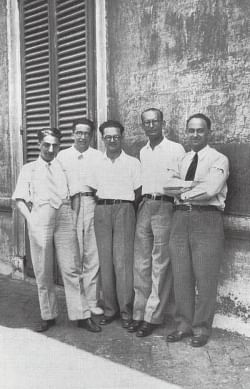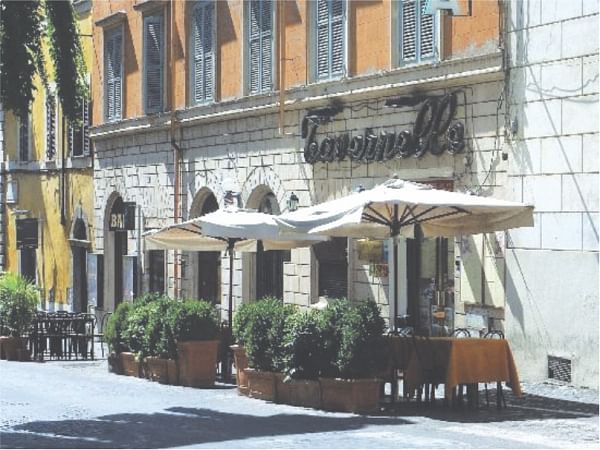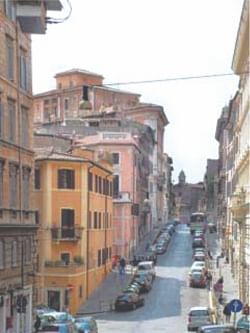| Home - Back Issues - The Team - Contact Us |
 |
| Volume 11 |Issue 20| May 18, 2012 | |
|
|
A Roman Column The Boys from Via Panisperna Neeman Sobhan No, that's not the name of a new boy band. The 'boys' are a curious part of Italian history: a group of young scientists whose joint discovery made possible the construction of the first atomic bomb. Yes, and I've dined with them at a historical restaurant called 'Le Tavernelle' on a historical road in Rome, the Via Panisperna. Well, 'dined with them' in a manner of speaking. More like, dined at the restaurant they frequented in the 1930's and where they are now framed on the wall in the famous black and white photo of the group. I Ragazzi di Via Panisperna.
So who were they and where is this Roman street? Before I enter into that story let me back track. I live not in the centre of Rome but a little outside, and the last metro station closest to my area is called EUR Fermi. It comes after the station called EUR Marconi and I have always known that both these stations were named after famous Italian scientists. Guglielmo Marconi and Enrico Fermi. One, famous for the radio; the other, for the nuclear reactor. The Eur Fermi station is on a pretty artificial lake in an area called EUR that was specially created by Mussolini to showcase modern or Fascist Rome. These days the metro stop is the site of a busy sidewalk market whose makeshift stalls are manned mostly by Bengali boys selling (often on behalf of Italian owners) clothes and bags and shoes and scarves and jewellery and sunglasses and household items and much else. Neither they, nor perhaps, their Italian customers know about the person behind the metro station's name. Enrico Fermi, known as the architect of the Nuclear Age, was a professor of theoretical physics at the University of Rome, and in 1938 won the Nobel Prize in Physics for his work on the atom, making possible the first nuclear reactor, which unfortunately led to the creation of the atomic bomb; but today Fermi's nuclear reactor is in common use in nuclear power plants. (Fermi shared the US patent with co-physicist Leo Szilard). So let us now go back to Via Panisperna, which in the twenties was the address of the Physics Institute of the University of Rome La Sapeinza, not far from my Institute of Oriental Studies near the Termini rail station. The 'boys' of the group were Edoardo Amaldi, Ettore Majorana, Bruno Pontecorvo, Franco Rasetti, Emilio Segrè and Oscar D'Agostino. All of them were physicists, except the last, who was a chemist.
The 'Le Tavernelle' is one of the oldest (210 years, circa) and most charming restaurants of Rome frequented by artists of the theatre world among others. The interior is elegant yet vibrant, with red walls decorated tastefully with framed photos of its interesting clientele, including the film director Fellini and Pope John Paul II. The owner tells you stories about his clients. Apparently Fellini's favourite dessert was Panna Cotta and the Pope's favourite dish, Salmon and spinach.
But I didn't hear what Fermi and his gang ate here, perhaps, because it was before the owner's time, or maybe, because I forgot to ask, faced with the gargantuan task of ordering my meal from the mouth watering menu. The place is a haunt for the locals so the food is authentic and in spite of its history, not touristy. I liked their seafood and the pastas. This whole area, the Rione Monti on the Viminale hills (one of the original seven hills of Rome) is full of history. The steep street, Via Panisperna, named after a monastery nearby, San Lorenzo in Panisperna, translates to 'bread and ham' after sandwiches that the church used to distribute in the past. The offices of the ministry of Interior is also located here, so now the word Viminale signifies the Interior ministry. And this is the neighbourhood where the seed of the Nuclear age was sown, by a group of young scientists led by Enrico Fermi, while rolling pasta around their fork and chattering enthusiastically about 'beta decay' and splitting a dessert while arguing about splitting atoms Prof Fermi, was later forced to emigrate when the Fascist racial laws were passed, since his wife was Jewish and it was harming his academic career. Fermi left fascist Italy with his family for Stockholm to receive the Nobel Prize in December 1938, and from there they left for the United States. Oscar D'Agostino and Edoardo Amaldi were the only ones who remained in Italy. The entire story, the human side of these nuclear physicists, is told in a 1989 film called 'I Ragazzi di via Panisperna' by film director Gianni Amelio.
|
||||||||
|


